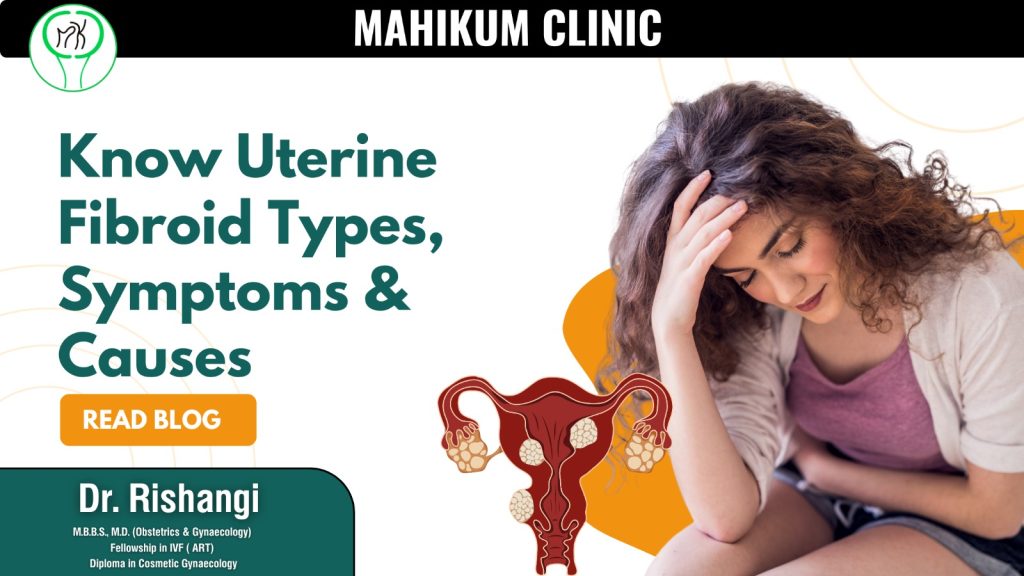
Uterine fibroids, also known as myomas or leiomyomas, are noncancerous growths that develop in or on the uterus. These common tumors affect up to 80% of women by age 50, yet many remain symptom-free and unaware of their presence. As a leading gynaecologist, Dr. Rishangi at Mahikum Clinic emphasizes early detection and personalized care to manage this condition effectively, especially for women in Greater Noida West seeking the best gynaecologist in Greater Noida West or the best fertility doctor in Greater Noida West.
In this blog, we’ll explore the different types of uterine fibroids, their symptoms, and underlying causes. Understanding these aspects is crucial for timely intervention, particularly if you’re planning a family, as fibroids can sometimes impact fertility and pregnancy. If you’re experiencing unusual symptoms, consult a specialist—Dr. Rishangi offers comprehensive evaluations at Mahikum Clinic to guide you toward optimal health.
What Are Uterine Fibroids?
Uterine fibroids are benign tumors composed of muscle and fibrous connective tissue that form in the uterine wall. They vary in size from tiny, pea-sized nodules to large masses resembling a melon and can appear singly or in clusters. While they rarely become cancerous (less than 1% of cases), their location and size determine whether they cause issues. Fibroids are most prevalent in women aged 30 to 50, shrinking naturally after menopause due to hormonal changes.
Types of Uterine Fibroids
Fibroids are classified based on their location within or around the uterus, which influences symptoms and treatment options. The four main types include:
1. Intramural Fibroids: These are the most common, developing within the muscular wall of the uterus. They can enlarge the uterus, leading to a feeling of fullness or pressure in the abdomen.
2. Subserosal Fibroids: Growing on the outer surface of the uterus, these can protrude outward, pressing on nearby organs like the bladder or rectum. They often cause backache or urinary issues without affecting menstrual flow directly.
3. Submucosal Fibroids: These bulge into the uterine cavity, just beneath the inner lining. Even small ones can cause heavy bleeding and fertility challenges, making them a concern for those seeking the **best fertility doctor in Greater Noida West*.
4. Pedunculated Fibroids: Attached to the uterus by a thin stalk, these can grow inside the cavity (pedunculated intramural) or outside (pedunculated subserosal), resembling mushrooms. They may twist, causing sudden pain.
Dr. Rishangi at Mahikum Clinic uses advanced imaging like ultrasounds to accurately identify fibroid types, ensuring tailored treatment plans.
Symptoms of Uterine Fibroids
Many women with fibroids experience no symptoms, with the condition often discovered during routine pelvic exams. However, when symptoms occur, they can significantly disrupt daily life. Common signs include:
– Heavy or Prolonged Menstrual Bleeding: The most frequent issue, potentially leading to anemia from blood loss.
– Pelvic Pain or Pressure: A dull ache in the lower abdomen, bloating, or a sensation of fullness, as if pregnant.
– Frequent Urination or Constipation: Larger fibroids press on the bladder or bowel, causing these inconveniences.
– Pain During Intercourse: Discomfort in the lower back or pelvis during sex.
– Bleeding Between Periods: Spotting or irregular bleeding that can signal submucosal fibroids.
In rare cases, fibroids contribute to infertility, miscarriages, or complications in pregnancy, such as preterm labor. Symptoms often improve post-menopause, but early consultation with the best gynaecologist in Greater Noida West like Dr. Rishangi can prevent escalation.
Causes and Risk Factors of Uterine Fibroids
The exact cause of uterine fibroids remains unknown, but research points to a combination of genetic, hormonal, and environmental factors. Key contributors include:
– Hormones: Estrogen and progesterone, which thicken the uterine lining each menstrual cycle, appear to stimulate fibroid growth. That’s why fibroids often shrink after menopause or during pregnancy when hormone levels fluctuate.
– Genetics: A family history increases risk; if your mother or sister had fibroids, you’re more likely to develop them.
– Other Risk Factors: African American women face higher incidence and severity. Early onset of menstruation (before age 10), obesity, vitamin D deficiency, high blood pressure, and diets high in red meat also elevate chances. Conversely, pregnancies, breastfeeding, and green vegetable-rich diets may offer protection.
At Mahikum Clinic, Dr. Rishangi assesses these risks holistically, recommending lifestyle adjustments alongside medical interventions.
When to Seek Help and Treatment Options
If you’re noticing heavy periods, persistent pelvic pain, or fertility concerns, don’t delay—schedule a visit with Dr. Rishangi, the best fertility doctor in Greater Noida West. Diagnosis typically involves a pelvic exam, ultrasound, or MRI.
Treatment varies by symptoms and fibroid characteristics:
– Watchful Waiting: For asymptomatic cases.
– Medications: Hormonal therapies like birth control pills to manage bleeding and pain.
– Minimally Invasive Procedures: Uterine artery embolization or radiofrequency ablation to shrink fibroids.
– Surgery: Myomectomy (fibroid removal) for fertility preservation or hysterectomy for severe cases.
As the best gynaecologist in Greater Noida West, Dr. Rishangi prioritizes fertility-sparing options and compassionate care at Mahikum Clinic.
Conclusion
Uterine fibroids are a widespread yet manageable condition, with types, symptoms, and causes varying widely among women. Armed with knowledge, you can take proactive steps toward better reproductive health. At Mahikum Clinic, Dr. Rishangi is dedicated to empowering women in Greater Noida West with expert guidance. Book your consultation today to discuss your concerns and reclaim your well-being.
